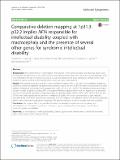| dc.contributor.author | Labonne, Jonathan D. J. | en_US |
| dc.contributor.author | Shen, Yiping | en_US |
| dc.contributor.author | Kong, Il-Keun | en_US |
| dc.contributor.author | Diamond, Michael P. | en_US |
| dc.contributor.author | Layman, Lawrence C. | en_US |
| dc.contributor.author | Kim, Hyung-Goo | en_US |
| dc.date.accessioned | 2016-04-01T15:47:51Z | |
| dc.date.issued | 2016 | en_US |
| dc.identifier.citation | Labonne, Jonathan D. J., Yiping Shen, Il-Keun Kong, Michael P. Diamond, Lawrence C. Layman, and Hyung-Goo Kim. 2016. “Comparative deletion mapping at 1p31.3-p32.2 implies NFIA responsible for intellectual disability coupled with macrocephaly and the presence of several other genes for syndromic intellectual disability.” Molecular Cytogenetics 9 (1): 24. doi:10.1186/s13039-016-0234-z. http://dx.doi.org/10.1186/s13039-016-0234-z. | en |
| dc.identifier.issn | 1755-8166 | en |
| dc.identifier.uri | http://nrs.harvard.edu/urn-3:HUL.InstRepos:26318592 | |
| dc.description.abstract | Background: While chromosome 1 is the largest chromosome in the human genome, less than two dozen cases of interstitial microdeletions in the short arm have been documented. More than half of the 1p microdeletion cases were reported in the pre-microarray era and as a result, the proximal and distal boundaries containing the exact number of genes involved in the microdeletions have not been clearly defined. Results: We revisited a previous case of a 10-year old female patient with a 1p32.1p32.3 microdeletion displaying syndromic intellectual disability. We performed microarray analysis as well as qPCR to define the proximal and distal deletion breakpoints and revised the karyotype from 1p32.1p32.3 to 1p31.3p32.2. The deleted chromosomal region contains at least 35 genes including NFIA. Comparative deletion mapping shows that this region can be dissected into five chromosomal segments containing at least six candidate genes (DAB1, HOOK1, NFIA, DOCK7, DNAJC6, and PDE4B) most likely responsible for syndromic intellectual disability, which was corroborated by their reduced transcript levels in RT-qPCR. Importantly, one patient with an intragenic microdeletion within NFIA and an additional patient with a balanced translocation disrupting NFIA display intellectual disability coupled with macrocephaly. Conclusion: We propose NFIA is responsible for intellectual disability coupled with macrocephaly, and microdeletions at 1p31.3p32.2 constitute a contiguous gene syndrome with several genes contributing to syndromic intellectual disability. | en |
| dc.language.iso | en_US | en |
| dc.publisher | BioMed Central | en |
| dc.relation.isversionof | doi:10.1186/s13039-016-0234-z | en |
| dc.relation.hasversion | http://www.ncbi.nlm.nih.gov/pmc/articles/PMC4797196/pdf/ | en |
| dash.license | LAA | en_US |
| dc.subject | 1p microdeletion | en |
| dc.subject | Intellectual disability | en |
| dc.subject | Delayed psychomotor development | en |
| dc.subject | Craniofacial anomalies | en |
| dc.subject | | en |
| dc.title | Comparative deletion mapping at 1p31.3-p32.2 implies NFIA responsible for intellectual disability coupled with macrocephaly and the presence of several other genes for syndromic intellectual disability | en |
| dc.type | Journal Article | en_US |
| dc.description.version | Version of Record | en |
| dc.relation.journal | Molecular Cytogenetics | en |
| dash.depositing.author | Shen, Yiping | en_US |
| dc.date.available | 2016-04-01T15:47:51Z | |
| dc.identifier.doi | 10.1186/s13039-016-0234-z | * |
| dash.contributor.affiliated | Shen, Yiping | |


